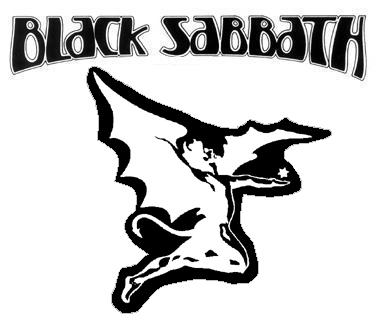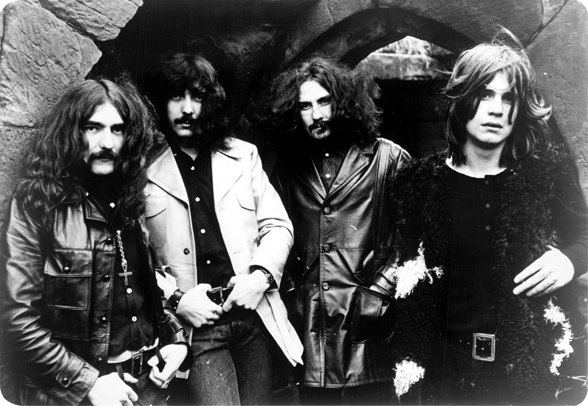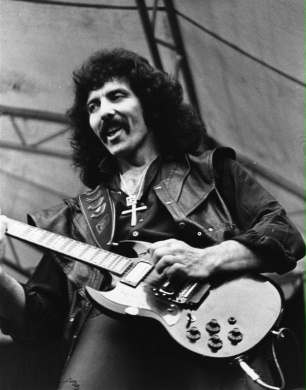
Black Sabbath Tribute, Part 2
There are a small handful of bands and artists that get mentioned as the greatest acts in rock and roll history, a sacred pantheon of untouchable musicians who have earned a reverence unlike any other kind of adulation in popular culture. They are icons, placed on a dais and worshipped with respect and deference that most bands or solo acts can barely feel a whisper of on their best day.
These are all names you know. The Beatles, The Rolling Stones, Eric Clapton, Billy Joel, Elton John, Bruce Springsteen, The Doors, Led Zeppelin, Pink Floyd, Elvis Presley, Johnny Cash, Jimi Hendrix, Chuck Berry, The Ramones, The Clash, Nirvana, The Police, David Bowie, Van Halen, Black Sabbath.
Odds are that anyone reading this owns an album of roughly half that list. They are the proverbial chosen ones, artists who are regarded as largely beyond reproach. They are a select group of innovators who shaped the way the world views rock and roll and taught entire generations about how music had no boundaries (well, except maybe Springsteen. Not sure how much innovation there was there. There, I said it. Moving on.) Even if an individual music listener is not a fan of one of those above bands, he or she can understand and respect the reasons of a listener who is.
The interesting thing about all of those bands is that their contribution to culture was more than musical, it was also societal (yes, the Boss, too.) Some of them contributed to the very rise of rock and roll in the 50’s, pulling us out of the Brill Building mold by combining soul, gospel and blues. Others contributed to the meteoric revolution of counter-culture in the 60’s, or fought off the demons of disco with Marshall stacks in the 70’s. They gave us punk and made us forget the conventions we had become accustomed to over the radio waves. Of course, Nirvana spearheaded the grunge movement that popularized “alternative” music, helped kill mass-marketed hair metal and left ripples that are still expanding today.
Black Sabbath is the proverbial black sheep of that group, however. They have earned the same stripes and enjoy the same legacy that is spoken about with respect and celebrated the world over. Yet, it’s a tougher test to singularly identify the societal impact of Black Sabbath. From a musical standpoint, their contribution was clear; they weren’t afraid to use the diminished fifth, distort their guitar or lyricze subject matter that was considered taboo. The band’s singular blend of edgy guitar, emphasis on brutal beats and down-and-dirty blues sensibilities led to the formation of modern heavy metal as we know it.
Therein however, lay the secret and quieter impact of Black Sabbath on the population. To this day, Black Sabbath songs carry a certain weight about them; whether at a party or hockey game or bar, everyone notices when the music changes to Black Sabbath. Rather than influence the mainstream, Black Sabbath created something outside of it that had never been heard before and would always stand apart from it. While it’s impossible to say that Black Sabbath created the idea of the musical underground (that lofty honor probably goes to someone like Robert Johnson,) it’s certainly true that they had a hand in shaping and popularizing it.
Black Sabbath’s legacy is more subtle now, but is deeply seated in the consciousness of music fans, and metal fans in particular. There is a built-in homage in just about every form of current rock and roll or metal, and Iommi and Butler are stamped in the brain of every hard rock or metal fan who has ever played an instrument. Whenever I pick up my bass and can’t think of anything to play or practice, my fingers idly, subconsciously start playing “N.I.B” (or “Black No. 1,” but we’re not here to pay tribute to Type O Negative, may Peter Steele rest in peace.) There is an indelible quality about Black Sabbath’s music that makes you want to play it just so, if at least for a short time, you can feel like a badass.
Most commonly with the bands of this pantheon, we hear anecdotes from fans about how they adore a particular act because that music spoke to their ideals and reinforced beliefs that they held at a specific moment in time.
What I’ve come to realize from putting together this tribute and speaking with fans, friends and musicians from all over, is that Black Sabbath didn’t identify with these peoples’ lives. Black Sabbath *changed* these peoples’ lives. Changed the way they thought about and listened to music, changed the way they saw societal issues and tropes, changed the way they marched in the parade of life. It’s a very different and much larger concept, one that is unique to the boys from Birmingham. In the final part of this tribute, coming later in the week, you’ll see persons from every walk of the music universe talk with ultimate respect toward the band that altered their outlook forever.
With all that said, my personal Top Ten Favorite Black Sabbath riffs are after the break:

Okay, just as with Greg’s list on Monday, you can click on any song title to hear that song in a new window. I strongly encourage doing so for songs you might not be familiar with, otherwise you’re missing out.
Honorable Mention comes first:
"Warning" is an easy honorable mention because of its artful construction and wonderfully casual pacing. It’s a well-crafted song that makes the best use of Black Sabbath’s blues sense. If you could break that song into pieces, there are some magnificent riffs in there, but its lack of metal chops and lengthy, wandering run time ultimately exclude it from this list.
“Fairies Wear Boots” is a little too inconsistent and patchwork to make an entry, but is absolutely essential on this list because of its soulful pacing mixed with hard-edged countenance. After the second verse, you could easily rock the more instrumental part of this song in the corner of some dusty, forlorn townie jazz club and get away with it. The song is sublime in its blending of elements. “Fairies Wear Boots” is unquestionably the inspiration for any number of other blues/doom/stoner metal bands to follow and not just because of its drug induced adventure, but because the riff lays down the groundwork for Monster Magnet, Fu Manchu, Type O Negative, Devil to Pay and who knows how many others.
10) Thrill of it All
This might be my “trying to be too smart and pick something unexpected,” art house pick, like when Sports Illustrated used to pick Colorado or Oregon State to win the NCAA football championship (back before the wicked and loathsome BCS.) Bear with me. Naturally, I’m not talking about the second, cheap, hippie-feel-good rock section, but the gritty, back alley section that takes place before the 2:45 mark. Not only is it a great, infectious hook, but that double clutch at the end of the riff has been copied and put to use by Judas Priest, Clutch, Priestess and a thousand other bands. It’s really too bad the back half of the song has to happen, but in a pure riff contest, that riff belongs here.
9) Hole in the Sky
One of the bluesiest (yes, I just made up that word,) riffs that Iommi ever composed, which comes as a surprise given how late it arrives in their career, when they had already expanded somewhat beyond their original blues scope. It doesn’t hut that Butler really dives into this one and helps support the backbone of the piece. What makes this work stand out among other bluesy Sabbath songs is how insistent and pounding the riff is. It repeats with little variation and makes you memorize it before it’s over. For a little known first track, “Hole in the Sky” is a kick-ass headbanging song by modern metal standards. This riff starts the album off so well that it almost makes you forget Bill Ward’s horrible fashion statement on the album cover. Almost.
8) Sabbath Bloody Sabbath
While the first half of this cut is pretty solid and comes to fight with a charged riff, it’s kind of generic by the lofty standard set by Black Sabbath over the course of their career. The second half though, after the three minute mark, is pure musical genius. In 1973, Black Sabbath had finally produced a reason for parents to fret over what their kids were listening to. By comparison, the other alleged “Fathers of Metal” Led Zeppelin, released “Houses of the Holy” that same year. A great record to be sure (don’t let me fool you, I love me some Zep,) but not on par with the crunchy, pulverizing destruction represented by the title cut from “Sabbath Bloody Sabbath.” The sheer, unadulterated, artless drudgery of that back-half riff was and is fear-inspiring; it creates an image of foreboding that is somehow more imminent that even the haunting “Black Sabbath.” All of metal owes this riff a drink at the bar. The only thing that keeps “Sabbath Bloody Sabbath” lower on this list than the next song is a lack of historical perspective.
7) Black Sabbath
Despite being maybe the least technically proficient riff of all time, “Black Sabbath” is an absolutely integral piece of the puzzle. In 1970, the cultural revolution of the sixties had taken complete hold, and pop culture was ready to embrace free love as an ideal. Musically, that meant the Jimi Hendrix Experience and Carlos Santana’s psychedelic riffs, but in a dirty coal mining town in England, Black Sabbath turned the dial the complete opposite way. “Black Sabbath” the song set the pace for doom and gloom a full eleven years prior to the menacing opening of Diamond Head’s “Am I Evil?” Add on that “Black Sabbath” was the first song on the first Black Sabbath album and therefore most people’s first impression of the band, and you have a powerful statement. This was the band’s beachhead into the rock scene and served as a capable launching pad for everything that followed.
6) Into the Void
So many things I love about this song. Foremost among them though, is that in the dread-soaked landscape of bleak, foreboding riffs that Black Sabbath inspired, they found time to stash this perfect power trip on an album cut. “Master of Reality” might be, in retrospect, the most “metal” of Sabbath albums and “Into the Void” is the pinnacle of that achievement. The riff blends both the baleful menace present in Sabbath’s best work with a solid sense of down-home rock and roll. Iommi bends this song from being a plodding, brooding monster into a sprinting, ravenous predator and back again. Wonderful stuff.
5) N.I.B
Might be the second catchiest riff Black Sabbath ever wrote, second only to the next song on the list. Just about flawless, though it lacks a certain flair that separates the next four from this track. What makes this riff work (aside from peerless note selection,) is not necessarily the space Iommi does fill, but the wonderful use of the space he doesn’t. I know, I know, that argument borders dangerously close to the uber-pretentious “you have to hear the notes he’s not playing!” argument. Still, Iommi’s use of open space to let this riff breathe and allow for better impact of each staccato phrase is one of his greatest achievements as a guitar player and a benchmark credit to his legacy. As an addendum, this is one of the few riffs ever written that is secretly easy on guitar but can make anyone who plays it sound like a legit axe-man. Remember, just because it's mostly a bass riff doesn't make it any less an awesome riff.
4) Iron Man
The Icon. The Megalith. The Forever. Nothing else needs be said.
3) Electric Funeral
The ability to write a song as uniquely depressing and deliciously macabre as “Electric Funeral” is what sets Black Sabbath apart from bands like Deep Purple, Cream and Led Zeppelin in the “Fathers of Metal” category. This is one of the most powerful, affecting riffs assembled in any era, period. That may be part of the reason there are so few covers of it. To do a cover, you have to feel like you can improve a song that already exists. The Iced Earth cover is a little bogus, and the Pantera cover is a solid showing, but doesn’t make the song better. There’s something about the stark depravity of Iommi’s anguished riff that sets it apart. Iommi did what no man has done before or since, which is perfectly match a riff to Ozzy’s caterwauling vocals. It merits mentioning that as a result of this perfect pairing, ONLY Ozzy Osbourne can sing this song correctly. No other Black Sabbath singer would be able to conjure up the necessary despair and discordant overtones to properly fit this song and this riff.
2) Symptom of the Universe
Doubles as possibly the best and most overlooked Sabbath song. It’s certainly a race between “Symptom” and “Into the Void.” In any event, this riff is the granddaddy of metal riffs and one of the most imitated riffs of all time. This was the first time that Sabbath pumped out a song with very little blues roots (save the calypso part at the end,) and experimented with pure power riffing. It has such authority, both because of the emphasis on a single note and because of the fuzzy production that removed all the clear edges. Part of the reason the Sepultura cover works so well is because “Symptom” practically sounds like an unfinished demo of one of their songs to begin with. It’s not hard to draw a parallel between this riff and the gallop riffs that would lead to the rise of speed metal in the early 80’s. Masterpiece.
1) Supernaut
What always amazes me about “Supernaut” is that the riff is so powerful that the song would be exactly the same if Geezer Butler never picked up his bass. Iommi is so strong, and the riff is so sharp, that the gulping line Butler uses to fill in Iommi’s empty space is practically superfluous. Not only that, but this was the absolute apex of the band’s synthesis between the tropes of blues and the formation of what would become metal. Never again on a Black Sabbath album would the two blend so perfectly. What gives the edge to “Supernaut” over “Symptom of the Universe” comes down to sole influence. “Symptom of the Universe” was released in 1975, a full three years after Deep Purple’s similar “Highway Star.” In 1973, there was nothing else like “Supernaut.” One of the best features of this riff is that it repeats for a while, then disappears for the middle of the song. Yet, upon its boomeranging return, the riff smacks the listener across the face with the same exact impact it did at the beginning. It is a truly rare feat in music to have a riff leave, come back two minutes later and be just as powerful as its initial rush. Riffs like this are the reason people still remember Black Sabbath and why their place atop metal’s pyramid has been unchallenged.
**Okay, two done, one to go! Keep sharing this link, and leave comments on your favorite Sabbath riffs! Keep it tuned here on Bloody Good Horror for Black Sabbath Tribute, Part 3, where I hand the stage over to musicians you know and love such as Henry Rollins, Jeff Duncan of Armored Saint and Paul Allender of Cradle of Filth, as they wax poetic about their favorite Iommi moments!


